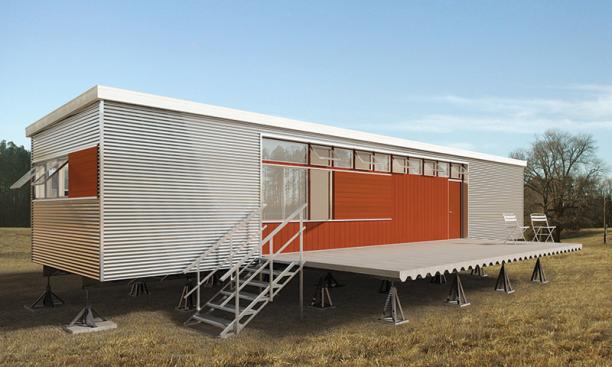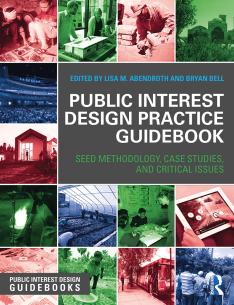My thesis was a response to architects Robert Venturi ’47 *50, Denise Scott Brown, and Steven Izenour, who proposed the idea of the Decorated Shed — an ordinary structure (which they call “a $10,000 shed”) where the outside is decorated independently of the structure’s practical purpose (donning a “$100,000 sign” of ornament). My response was to ask: How could the $10,000 shed be elevated to architecture for people who couldn’t afford the $100,000 sign? I titled it The Undecorated Shed.
I received a B+, good enough for me at the time as an “athletic admit,” but along the way Princeton did teach me to ask critical questions and gave me the belief that we can answer them. As it turns out, the black-bounded volume I dropped off at the Department of Art and Archaeology was just the beginning of the real work.
The path from there started out conventionally enough: first to Yale for a master’s degree in architecture, and then to my “dream job” in New York at Steven Holl Architects. After one year, the dream became a wake-up call. The traditional practice of architecture wasn’t for me. I wanted to find how architecture could address critical challenges in the world such as hunger, disease, poverty, disasters, and safe housing. Could there be a field of public interest design that would serve the missing gaps of services, like public health and public interest law?
I returned to explore the idea of the undecorated shed in less obvious locations. First, I went to rural Pennsylvania to work with migrant farmworkers, who, as a marginalized group, are among the worst housed (in chicken coops, old mobile homes, etc.) and earn the lowest income levels in the nation. Collaborating with the workers, social services, and farmers, we developed homes that responded specifically to the needs of migrant workers. This work led to the origination of my nonprofit organization, Design Corps.
There have been challenges along the way. I’ve been homeless twice, but that has been self-inflicted by my quixotic career path and does not compare to the crushing systemic homelessness of so many in this country.I was blessed with parents, and now with a wife, who never asked what on Earth I was doing — apparently working hard to barely earn a living. While I’ve never seen myself as unemployed, I can say for sure that I have significantly and single-handedly lowered my class’s average salary.
There has been wonderful support as well: a Loeb Fellowship at Harvard, seven grants from the National Endowment for the Arts to support projects, and a $100,000 Latrobe Prize from the American Institute of Architects’ College of Fellows that I shared with three close colleagues. (The Loeb Fellowship provided me with a $50,000 stipend and zero tuition to attend Harvard for a year, which led a Princeton classmate to say, “You couldn’t pay me to go to Harvard.”) There’s also been many inspiring mentors and colleagues and hundreds of others who have all worked to show that architecture can better serve the public. These projects are addressing the critical issues in the world, although so much more needs to be done. Most importantly, these projects have been created with communities, not just for communities.
As a massive collective effort by many, we may be getting close to a career where you can get paid to serve the public through design.
There was also a meaningful honor from my class: At Reunions in 2003 I was given The Class of 1983 Memorial Award for embodying “the nobler spirit of the class.” The only other time I have risen to distinction among my distinguished class was for the “Ken Doll Runner-up” award during our Class Day in 1983.
Along the way, I’ve organized 19 conferences, conducted 33 institutes, and co-published five books on this subject. The books document the work of many designers and activists from all over the world. Each year there are more architecture projects created that address the critical social, economic, and environmental challenges faced around the world. As a massive collective effort by many, we may be getting close to a career where you can get paid to serve the public through design.

Now I can say that I am a “public interest designer.” It feels good to know what to call myself, rather than just an “alternative career person.” It is gratifying to have a name for my profession, and also gratifying that others do too, especially young designers who are already making great steps forward.
But not many people outside of architecture read the books I’ve published. For a field that serves the public, the public needs to be the key participant in this conversation. One day I hope to publish a novel that a few non-architects may actually read. I started to write one the year after graduation, also called The Undecorated Shed, and have rewritten it twice since then. These drafts are all really bad. Like most first novels, it is a thinly veiled autobiography about this experience. I don’t think anybody I’ve given it to has actually read the whole thing.
I figure that the chances of publishing a novel must be slightly lower than helping start a new profession. I did take creative writing as a senior, and while I don’t remember my grade, I know that I didn’t fail. That is good enough to encourage me to keep working on it. It will be an enjoyable time of reflection about the past and keep me busy in retirement.
And having just celebrated my 40th reunion, I’m hoping that by my 50th I will finally be able to prove my thesis.


